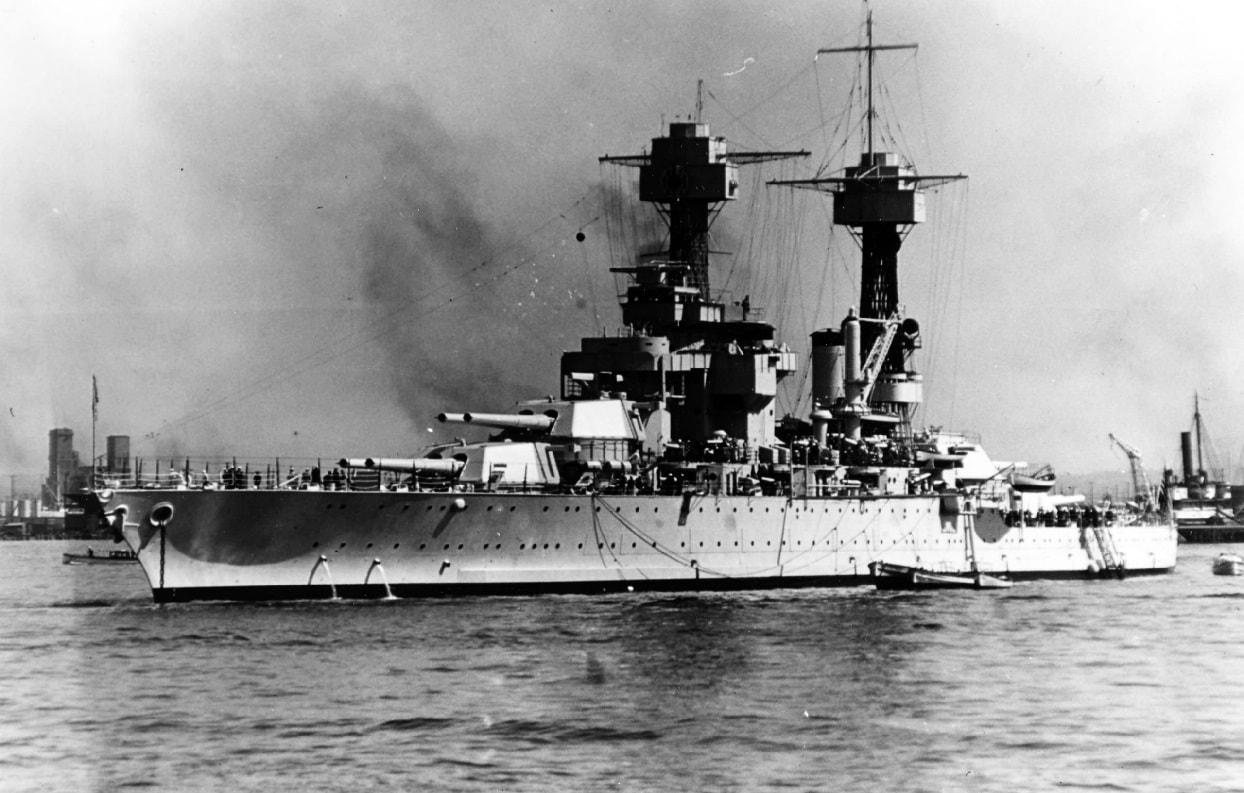Battleship USS Maryland, a 4 Minute History Lesson: Laid down at Newport News Shipbuilding in April 1917, and commissioned in July 1921, USS Maryland (BB-46) was the second of the planned four-strong Colorado-class of dreadnought battleships – the last of the “Standard Type” – that were built at the end of the First World War. She was the third ship of the U.S. Navy to be named in honor of the Old Line State. Like her sister vessels, the 32,600-ton warship was essentially identical to the preceding Tennessee-class of warships, except in that the armament was increased from twelve 14-inch (356mm) main guns to eight 16-inch (406mm) Mark 1 guns in four twin-gun turrets on the centerline.
Secondary armament included sixteen 5-inch (127mm)/51 caliber guns that were mounted individually in casemates clustered in superstructure amidships. The warship was also armed with an anti-aircraft battery of eight 3-inch (76mm)/50 caliber guns in individual high-angle mounts. USS Maryland was also equipped with a 21-inch (533mm) torpedo tube mounted in her hull below the waterline on each broadside.
In addition to her powerful armament, she was well armored with a main belt of eight-to-13.5-inches (203 to 343mm) thick, while the main armored deck was up to 3.5-inches (89mm) thick. Her conning tower had 16-inches (406mm) thick sides, and the main battery turrets had up to 18-inches (457mm) thick faces. Up to three floatplane aircraft could be carried for “over-the-horizon” reconnaissance and light anti-ship duties, and each was launched via a pair of catapults, while being recovered via the use of an onboard crane.
As with the other Colorado-class warships, she was powered by four General Electric turbo-electric drives with steam provided by eight oil-fired Babcock & Wilcox boilers. The ship’s propulsion system was rated at 28,900 shaft horsepower (21,600 kW) for a top speed of 21 knots (39 km/h; 24 mph), while her range was approximately 8,000 nautical miles (9,200 miles). Her crew consisted of 1,080 sailors including officers.
She first served as the flagship of the fleet in the early interwar years for Commander-in-Chief, U.S. Atlantic Fleet Admiral Hilary P. Jones. USS Maryland later served in the Battle Fleet and was among the battleships to conduct a goodwill cruise to Australia and New Zealand in 1924, and just three years later, carried President-elect Herbert Hoover on a tour of Latin America before returning to the United States for her first significant overhaul.
In 1940, USS Maryland’s base – along with the other battleships of the Battle Force – was changed from Long Beach, California to Pearl Harbor, Hawaii. As a result, she was moored at Pearl Harbor on December 7, 1941 and came under attack from Japanese aircraft. Unlike many of the other warships that took significant, even catastrophic damage that day, BB-46 was not seriously impacted and was quickly repaired and overhauled.
USS Maryland operated with Task Force One off the U.S. West Coast in 1942, before being deployed to the South Pacific later in the year. The battleship took part in operations to capture the Gilbert and Marshall Islands in late 1943 and early 1944. She supported the United States Marine Corps’ landings, where she employed her sixteen-inch guns in the pre-invasion bombardments of Tarawa and Kwajalein. In June 1944, USS Maryland also participated in the pre-invasion bombardment of Saipan, and it was during the engagement that she was torpedoed by a Japanese aircraft.
After returning to Pearl Harbor for repairs, she was deployed to take part in the Leyte invasion in the Philippines and was she was present at the Battle of the Surigao Strait, one of only two battleship-versus-battleship naval sorties of the war and the last battleship-to-battleship action in history. Operating off Leyte a month after the battle, in November, Maryland was damaged in a “Kamikaze” attack.
Repaired again, she was able to take part in the Okinawa invasion in March/April 1945 and was again damaged from a Japanese aerial attack. However, she remained in action for another week, and she only returned to service following repairs after the war had ended. USS Maryland spent the final months of 1945 transporting servicemen home as part of Operation Magic Carpet. Decommissioned in April 1947, she was in “mothballs” until July 1959 when she was sold for scrapping.
Peter Suciu is a Michigan-based writer who has contributed to more than four dozen magazines, newspapers and websites. He regularly writes about military small arms, and is the author of several books on military headgear including A Gallery of Military Headdress, which is available on Amazon.com.

